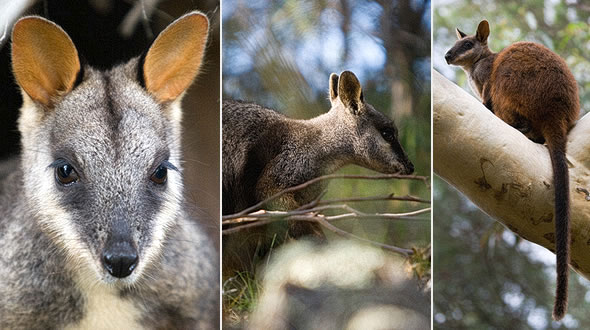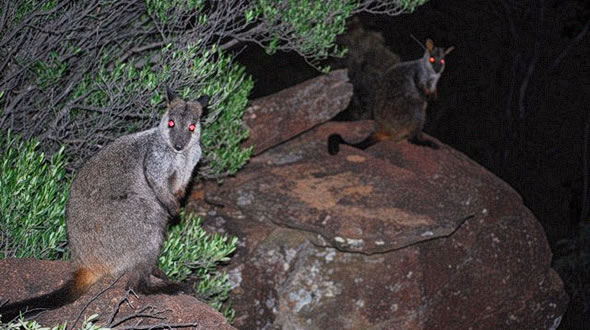What do they look like?
The Brush-tailed Rock-wallaby is relatively small and muscular, about 50 centimetres tall with adults weighing between 5-8 kilograms. This enables them to be fast and agile in their rocky habitat.
 Photos: Ben Bishop
Photos: Ben BishopTheir fur is generally brown, with lighter, grey shoulders, a reddish/brownish rump, white cheek stripes and a black stripe that runs from their forehead, between their ears, to the back of their head.
As its name implies, the distinguishing feature of this species is the long (about 70 centimetres) brown-black brushy tail. This tail gives them incredible balance and along with its well padded, rough textured feet giving them extraordinary grip to hop between boulders and up and down steep rocky slopes.
The highest numbers of Brush-tailed Rock-wallaby are likely to be seen on the feeding ground early in the night.
 Photo: Katherine Tuft
Photo: Katherine TuftNot Swampies!
They are sometimes confused with the larger, more common Swamp or Black Wallaby.
They occasionally use the same rocky habitat yet Swamp Wallabies are much larger at around 70 centimetres tall and weighing around 10-15 kilograms. The Swamp Wallaby has rufous-coloured fur around the base of its ears and lack the Brush-tailed Rock-wallaby’s long brushy tail.
Swamp Wallabies move with their heads held low and their tail held out straight behind them when jumping, whereas Brush-tailed Rock-wallabies hold their head and tail up high.
State Information
What you can do!
An important aspect of Brush-tailed Rock-wallaby recovery is the active involvement of local landholders and the community overall. See what you can do!
Resources
- Vortex Project Brief
- The Shadow – Newsletter of Brush-tailed Rock-wallaby conservation in Victoria
Did you know?
Before European settlement, Brush-tailed Rock-wallabies were widespread throughout southern Queensland, New South Wales and Victoria. At the beginning of the twentieth century over half a million animals were killed for the fur trade and as agricultural pests.






